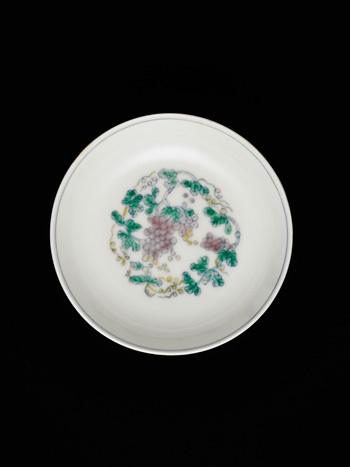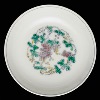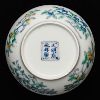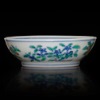The delicate depiction of luscious grape on the present lot testifies to the sophisticated composition of Chenghua porcelain and is among the rarest and most highly prized of Chenghua porcelain. Although porcelain adorned with the grape design existed as far back as the Yuan dynasty, the Chenghua prototype is considered as far more superior due to the subtlety of its composition, the brilliance of its colors and liveliness of the drawing. Chenghua doucai wares were not merely made for daily usage in the Palace, they were also special Imperial ware intended for appreciation due to the political developments of the Imperial palace at the time. In the book, Gutong ciqi kao (A study of the ancient bronzes and porcelain), Liang Tongshu commented, “The Chenghua porcelain are the best of all the overglazed painted wares of the past. They are finely painted with the best enamels and are at times even more vividly and marvelously executed than the comparable works of old masters.” The origin for the grape design may have been sketches from nature, possibly in the Imperial gardens during the summer and autumn seasons. Its composition may also have been partially derived or adopted from paintings such as a hand scroll with grapes by the Song monk Wen Riguan and Jigang, who had been complimented time and again on his distinguish ability to paint grapes. Furthermore, the subject matter of grapes with their multiple fruits symbolize fertility, continuity of the family line, abundance, and vigorous growth, these auspicious attributes made have contributed to its appearance on vessels to be used on celebratory occasions, particularly for Chenghua Imperial porcelain. According to the Gu Tai in Bowu yaolan (Important criteria for studying ancient objects), small dishes similar to the present lot were rarely made before the Chenghua period. The delicate small dish was intended to be utilized as chopstick holder during large celebratory banquets along with a coordinated set of matching wine cups and stem cups during the late Chenghua period. Compare with a doucai cup with bunches of grapes hanging down from thick foliage and a stem cup and a stemcup decorated with entwining vines, illustrated in A Legacy of Chenghua. Imperial porcelain of the Chenghua reign excavated from Zhushan. Jingdezhen, the Tusi Museum of Art, Hong Kong, 1993, C100, C117 and C104, pp.288-289. Compare also with a grape dish exhibited at the National Palace Museum, illustrated in Everlasting Chenghua porcelain, National Palace Museum, 2003, pp.3637. See also the aforementioned wine cups and stem cups made to be used as a set, illustrated in The emperor’s broken China. Reconstructing Chenghua porcelain. An exhibition of Chinese porcelain of the Chenghua period recently excavated from the Imperial kiln site at Jingdezhen in South China, 2010. Courtesy of the National Palace Museum, Taipei台北國立故宮博物院
|
8104
A RARE DOUCAI GRAPE DISH
CHENGHUA WITH SIX CHARACTER REIGN MARK (1465-1487) |
|
Exquisitely potted with rounded sides resting on a circular footring, the exterior encircled with alternating fruiting peaches sprigs and flowering leafy magnolia sprigs set in between two bands of lines in underglazed blue, the interior enameled at the center with grapes borne on meandering leafy vines bearing succulent strands of grapes, the recessed base with a six-character reign mark enclosed in a double square cartouche. |
|
Estimate
5,200,000 - 8,320,000 20,313,000 - 32,500,000 670,100 - 1,072,200
|
|
|
The delicate depiction of luscious grape on the present lot testifies to the sophisticated composition of Chenghua porcelain and is among the rarest and most highly prized of Chenghua porcelain. Although porcelain adorned with the grape design existed as far back as the Yuan dynasty, the Chenghua prototype is considered as far more superior due to the subtlety of its composition, the brilliance of its colors and liveliness of the drawing. Chenghua doucai wares were not merely made for daily usage in the Palace, they were also special Imperial ware intended for appreciation due to the political developments of the Imperial palace at the time. In the book, Gutong ciqi kao (A study of the ancient bronzes and porcelain), Liang Tongshu commented, “The Chenghua porcelain are the best of all the overglazed painted wares of the past. They are finely painted with the best enamels and are at times even more vividly and marvelously executed than the comparable works of old masters.” The origin for the grape design may have been sketches from nature, possibly in the Imperial gardens during the summer and autumn seasons. Its composition may also have been partially derived or adopted from paintings such as a hand scroll with grapes by the Song monk Wen Riguan and Jigang, who had been complimented time and again on his distinguish ability to paint grapes. Furthermore, the subject matter of grapes with their multiple fruits symbolize fertility, continuity of the family line, abundance, and vigorous growth, these auspicious attributes made have contributed to its appearance on vessels to be used on celebratory occasions, particularly for Chenghua Imperial porcelain. According to the Gu Tai in Bowu yaolan (Important criteria for studying ancient objects), small dishes similar to the present lot were rarely made before the Chenghua period. The delicate small dish was intended to be utilized as chopstick holder during large celebratory banquets along with a coordinated set of matching wine cups and stem cups during the late Chenghua period. Compare with a doucai cup with bunches of grapes hanging down from thick foliage and a stem cup and a stemcup decorated with entwining vines, illustrated in A Legacy of Chenghua. Imperial porcelain of the Chenghua reign excavated from Zhushan. Jingdezhen, the Tusi Museum of Art, Hong Kong, 1993, C100, C117 and C104, pp.288-289. Compare also with a grape dish exhibited at the National Palace Museum, illustrated in Everlasting Chenghua porcelain, National Palace Museum, 2003, pp.3637. See also the aforementioned wine cups and stem cups made to be used as a set, illustrated in The emperor’s broken China. Reconstructing Chenghua porcelain. An exhibition of Chinese porcelain of the Chenghua period recently excavated from the Imperial kiln site at Jingdezhen in South China, 2010. Courtesy of the National Palace Museum, Taipei台北國立故宮博物院



